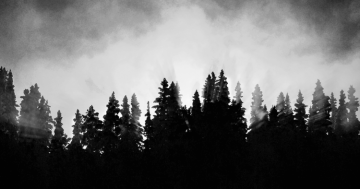Sudip Bose at The American Scholar:
 I cannot think of a contemporary piece that has attracted as much of a cult following as Haas’s mesmerizing, disorienting, and utterly moving in vain. It begins with a swirl of sound in which the cascading runs suggest a sense of falling, yet as these lines rise in pitch, there’s a feeling of upward motion, too—the musical equivalent, as many commentators have noted, of M. C. Escher’s staircase, descending and ascending all at once. Soon after a hair-raising crescendo, the listener is plunged into another realm, in which microtonality seems at war with conventional tuning. The sounds pulse like flashes of light through an abiding darkness, which is not only metaphorical but also literal, for in a live performance, the house lights gradually dim and are then cut. (Unable to see either their music stands or the conductor, the performers must play extended sequences of very complex music from memory.) Out of this darkness, a new world of sound emerges, something elemental—familiar but strange—with the textures and harmonies undergoing subtle transformations. Just when it seems as if some redemptive moment will arrive, the music becomes frustratingly dizzying once again. Indeed, listening to in vain can feel like being trapped in an anxiety dream from which you almost manage to escape, but ultimately cannot.
I cannot think of a contemporary piece that has attracted as much of a cult following as Haas’s mesmerizing, disorienting, and utterly moving in vain. It begins with a swirl of sound in which the cascading runs suggest a sense of falling, yet as these lines rise in pitch, there’s a feeling of upward motion, too—the musical equivalent, as many commentators have noted, of M. C. Escher’s staircase, descending and ascending all at once. Soon after a hair-raising crescendo, the listener is plunged into another realm, in which microtonality seems at war with conventional tuning. The sounds pulse like flashes of light through an abiding darkness, which is not only metaphorical but also literal, for in a live performance, the house lights gradually dim and are then cut. (Unable to see either their music stands or the conductor, the performers must play extended sequences of very complex music from memory.) Out of this darkness, a new world of sound emerges, something elemental—familiar but strange—with the textures and harmonies undergoing subtle transformations. Just when it seems as if some redemptive moment will arrive, the music becomes frustratingly dizzying once again. Indeed, listening to in vain can feel like being trapped in an anxiety dream from which you almost manage to escape, but ultimately cannot.
more here.
